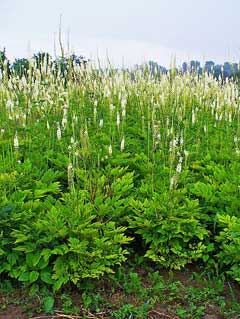Swedish botanist Carl Linnaeus published
the name Actaea racemosa in Species Plantarum in 1753. On noting the marked
difference between the dry follicles produced by black cohosh and the bright
fleshy fruits of some other Actaea species, British-American botanist Thomas
Nuttall moved this plant to the genus Cimicifuga in 1818. There it remained,
as Cimicifuga racemosa , until 1998 when scientists studying the entire group
concluded that, in spite of the differing fruits, the genera Actaea and Cimicifuga
are so genetically similar that they should not remain separate. Hence black
cohosh is often known by the synonym Cimicifuga racemosa, which was considered
the correct scientific name for this species until relatively recently.
[1] British Herbal Pharmacopoeia 1983
Published by the British Herbal Medicine Association ISBN 0 903032 07 4.
[2] Herbal Materia Medica Course Notes For Diploma of Naturopathy and Diploma
of Herbalism Students by Lydia Mottram.
[3] Mediherb- A herbal extract company based in Warwick Qld. 4370 Australia
www.mediherb.com
[4] Potter's New Cyclopaedia of Botanical Drugs and Preparations R.C.
Wren Revised by Elizabeth M. Williamson and Fred J Evans. First published in
Great Britain in 1988 and reprinted in 1989 and 1994 by the C. W. Daniel Company
Limited. 1 Church Path, Saffron Walden Essex. Published 1988 Printed and bound
by Biddles, Guildford ISBN 085207 1973.
[5] The Pharmaceutical Plant Company Pty Ltd
ppcherbs.com.au
Images
1.
commons.wikimedia.org
by Llez
2.
theherbhound.blogspot Triterpene glycosides, including actein,
cimigoside, cimiguine and racemoside.[2,3,4]
Isoflavones such as formononetin.[5]
Isoferulic acid.[6]
Volatile oil.[6] Tannin.[1,6]
Resin- cimicifugin.[1,2] Salicylic
acid.[1] Traces of an alkaloid and
crystalline alcohols.[1]
Racemoside has antiulcer activity in mice,[3]
and isoferulic acid lowers body temperature in rats.[4]
References
[1] British Herbal Pharmacopoeia 1983 Published by the British Herbal Medicine
Association ISBN 0 903032 07 4.
[2] Radics, L. et al. (1975) Tet Lett. 48, 4287
[3] Sundtry Ltd (1984) Pat. Jp 84/20298 Japan
[4] Shibata, M. (1977) J. Chem. Soc. Jpn. 97, 911
[5] Jarry , H. et al. (1985) Plant Med 4, 316
[6] Encyclopedia of Common Natural Ingredients used in Food Drugs and Cosmetics,
Albert Y. Leung. Pub. John Wiely & Sons Inc (1980) NY
 Actaea racemosa, Cimicifuga racemosa Black cohosh, Black snakeroot, Bugbane, Rattleroot, Macrotis, Squawroot
Family: Ranunculaceae
Actaea racemosa, Cimicifuga racemosa Black cohosh, Black snakeroot, Bugbane, Rattleroot, Macrotis, Squawroot
Family: Ranunculaceae
